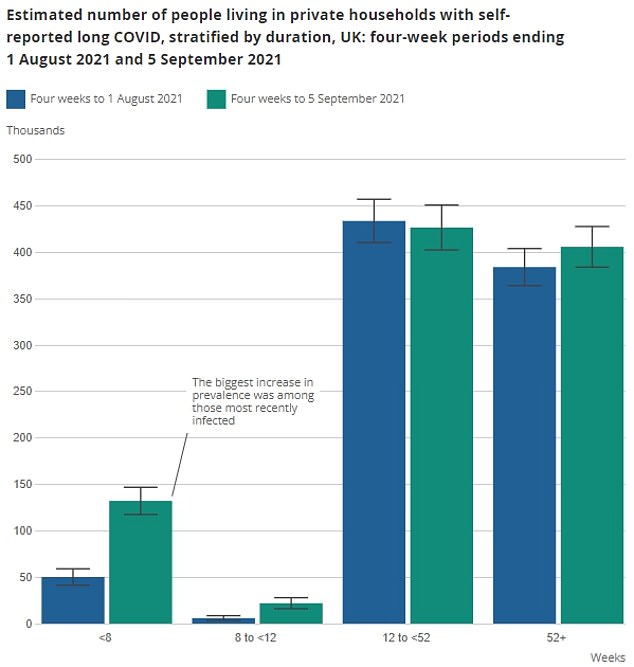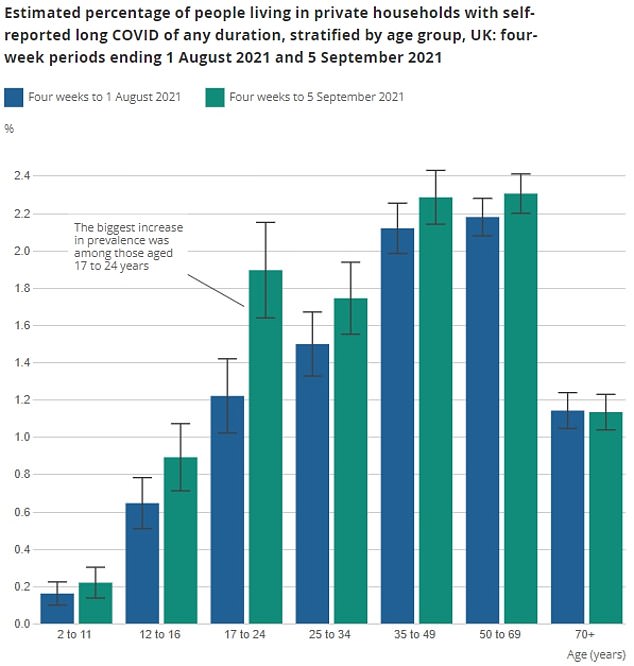More than 400,000 Britons have been struggling with long Covid for more than 12 months, official data suggests.
The estimate from the Office for National Statistics equates to 0.63 per cent of the entire UK population.
Meanwhile, the statistics body calculated that 1.1million people in the UK (1.7 per cent) in September had lasting symptoms following a bout of coronavirus.
Sufferers cite extreme tiredness, breathing difficulties, a loss of smell and problems concentrating as the main indicators of the condition – which the ONS classifies as symptoms that last more than four weeks after Covid.
But the figures are based on a survey of 300,000 people and not everyone who said they had long Covid tested positive for the virus.
Experts today warned the ONS estimates are likely overblown, due to those who link headaches and tiredness that is unrelated to the virus with long Covid.
And one said they ‘really do not believe’ that hundreds of thousands of coronavirus survivors have been left battling persistent effects of the disease for a year.

The ONS graph shows the estimated percentage of people currently suffering from long Covid based on their profession in the four weeks up to September 5 (green line) compared to the month leading up to August 1 (blue line). The data shows those working in health and social care were most likely to self-report suffering from the condition, followed by hospitality workers and civil servants

The ONS estimates that 405,000 people across the UK have been suffering from long Covid for more than a year, while
The proportion of people battling symptoms for more than a year – which the ONS estimates is 405,000 – varied significantly among different groups.
Women (0.71 per cent), white people (0.64 per cent) and 50 to 69-year-olds (1 per cent) were more likely to report suffering from the condition.
People working in healthcare (1.46 per cent), social care (1.17 per cent), hospitality (0.94 per cent) and the civil service (0.91 per cent) were much more likely to have long Covid.
WHO WAS MOST LIKELY TO HAVE LONG COVID FOR MORE THAN ONE YEAR?
The ONS surveyed around 300,000 people across the UK to estimate how many Britons were suffering from long Covid.
It estimated that 0.63 per cent of the population had the condition for more than a year, but some groups were more likely to be affected.
50 to 69-year-olds: 1%
Women: 0.7%
White people: 0.64%
People from the North East: 0.9%
Those from most deprived areas: 0.7%
Healthcare workers: 1.46%
Social care workers: 1.17%
Civil servants: 0.91%
Those with a severe disability: 1.81%
Advertisement
And people from the most deprived areas were at higher risk (0.69 per cent), compared to those from the least deprived areas (0.53 per cent).
Meanwhile, people who have a disability that limits their activity a lot (1.81 per cent) had long Covid, compared to those with no health conditions (0.47 per cent).
Overall, 37 per cent of the 1.1million people the ONS estimates have long Covid have been suffering for at least one year.
And more than three-quarters have had the condition for at least three months.
Two-thirds of people say the conditions affects their daily life, while one in five say their day-to-day activities have been limited ‘a lot’.
Fatigue is the most commonly reported symptom, with more than half of those with the condition affected by it.
It is followed by shortness of breath (40 per cent), loss of smell (32 per cent), and difficulty concentrating (31 per cent).
Professor David Livermore, a medical microbiologist at the University of East Anglia, told MailOnline that long Covid sufferers have to be split into three groups.
The first is people who were so ill from the virus that they were admitted to ICU.
‘If you’ve been sick enough to land in ICU you take a long time to recover whether its from Covid or, for example, bacterial pneumonia,’ he said.
The second is people who have one or more clear and persistent symptoms, such as a loss of taste, or being unable to walk upstairs without running out of breath, Professor Livermore said.
He said: ‘This as a post-viral syndrome and one sees such syndromes following other viral infections too, for example with glandular fever.
‘For me, this is true “long Covid”. It is clearly concerning, but not hugely common. ‘

Long Covid rates in the month leading up to September 5 (green bars) were highest among those aged 50 to 69, followed by those aged 35 to 49. But the biggest increase in the prevalence of long Covid was seen among 17 to 24-year-olds, with just 1.2 per cent suffering long lasting symptoms in August, but 1.9 per cent battling the condition by September
Professor Livermore said: ‘The third and far the largest and least serious group whom the ONS includes, are folks who have mild and variable self-reported symptoms.
‘The problem here is, as the the ONS themselves recently said, is that such symptoms as occasional headaches and fatigue are common anyway, regardless of whether you’ve had Covid or not.
‘So, the fact you’re feeling somewhat tired isn’t necessarily a result of the Covid infection you had a few weeks ago.
Number of Britons falling ill with Covid every day is now at ‘highest level since JANUARY’
The number of Britons falling ill with Covid jumped by nearly 14 per cent last week to the highest level since January, according to the UK’s largest symptom-tracking study.
King’s College London scientists estimated 66,033 people were getting infected every day in the week ending October 2, up 13.6 per cent from 58,126 the week before.
Cases in children appear to be turning a corner but are still extremely high, with around one in 30 school pupils contracting the virus — nearly three times more than the next highest rate in 35 to 55-year-olds.
Professor Tim Spector, the epidemiologist who leads the study, said allowing Covid to ‘run rampant’ in schools was ‘a real gamble’. He said he hoped that ‘herd immunity will kick in and cases will drop’ in children soon.
It came as new Education Secretary Nadhim Zahawi admitted that face masks could make a return in schools this winter if cases show no sign of slowing down.
The rising figures come despite Government data showing positive tests were still falling last week, with official case numbers only picking up for the first time in six days yesterday.
The Government’s Covid dashboard showed there were 39,851 new positive tests yesterday, up 8.5 per cent on last Wednesday’s count of 36,722. It was the largest daily toll since September 6 (41,192).
Advertisement
‘I really do not believe that we have 405,000 people with true long Covid – meaning my second group – lasting 12 months.’
He noted that a study from Harvard Medical School last week listed anxiety as a symptom of long Covid in US children.
‘That’s absurd – anxiety is most likely a result of the stresses of the past year, and of getting what their parent maybe felt was a “dread disease”, not of “long Covid”‘, he added.
Professor Kevin McConway, emeritus professor of applied statistics at The Open University, told MailOnline said ‘it’s possible’ that the figures are over estimated, because they are based on self-reporting.
‘There’s not any kind of independent check that people really do have the symptoms they say they have. They aren’t examined or diagnosed by health professionals,’ he said.
But he noted that most of the long Covid symptoms ‘are the kind of thing that inevitably has a subjective element anyway, and it’s never clear exactly what health professionals would add to diagnosis’.
Professor McConway said: ‘Also, while it’s obviously possible that some people report symptoms that they haven’t really got, it can work the other way too – some people may have symptoms but would rather not disclose them, even in a survey where their results would be kept confidential.’
He added: ‘There certainly is a possibility that some of these people have symptoms that were not actually caused by the virus, even though they firmly believe that they were caused by the virus (or, at least, not by anything else they know of).
‘But, first, there’s no measure of how large an issue that might be – some other studies have found long Covid to be more common than these ONS figures, and some have found it less common.
‘Also, if people do have these symptoms, particularly if they are having big effects on their day-to-day activities (as is the case for 90,000 of them), that’s an important health problem whether or not the symptoms were definitely caused by the virus.’
Layla Moran, Liberal Democrat MP and chair of the all-party parliamentary group on coronavirus said the rise in long Covid cases should ‘give pause’ to the Government’s ‘rush to get people back to the office’.
She said: “It’s been over a year since we first raised the issue of long Covid with the Government and nine months since we first debated it in Parliament, and yet we have not seen any evidence that the Government is considering long Covid when making serious policy decisions.’
Hundreds of thousands more people now have the long-term condition and ministers ‘must take urgent action now to reduce transmission and provide support for those now living with the consequences of their haste to remove even the smallest preventative measures’, Ms Moran added.
Source link : https://www.dailymail.co.uk/news/article-10068647/More-400-000-people-Britain-suffering-long-Covid-year.html











